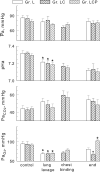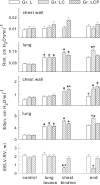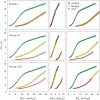Maintaining end-expiratory transpulmonary pressure prevents worsening of ventilator-induced lung injury caused by chest wall constriction in surfactant-depleted rats
- PMID: 20890197
- PMCID: PMC3995420
- DOI: 10.1097/CCM.0b013e3181fa02b8
Maintaining end-expiratory transpulmonary pressure prevents worsening of ventilator-induced lung injury caused by chest wall constriction in surfactant-depleted rats
Abstract
Objective: To see whether in acute lung injury 1) compression of the lungs caused by thoracoabdominal constriction degrades lung function and worsens ventilator-induced lung injury; and 2) maintaining end-expiratory transpulmonary pressure by increasing positive end-expiratory pressure reduces the deleterious effects of chest wall constriction.
Design: Experimental study in rats.
Setting: Physiology laboratory.
Interventions: Acute lung injury was induced in three groups of nine rats by saline lavage. Nine animals immediately killed served as a control group. Group L had lavage only, group LC had the chest wall constricted with an elastic binder, and group LCP had the same chest constriction but with positive end-expiratory pressure raised to maintain end-expiratory transpulmonary pressure. After lavage, all groups were ventilated with the same pattern for 1½ hrs.
Measurements and main results: Transpulmonary pressure, measured with an esophageal balloon catheter, lung volume changes, arterial blood gasses, and pH were assessed during mechanical ventilation. Lung wet-to-dry ratio, albumin, tumor necrosis factor-α, interleukin-1β, interleukin-6, interleukin-10, and macrophage inflammatory protein-2 in serum and bronchoalveolar lavage fluid and serum E-selectin and von Willebrand Factor were measured at the end of mechanical ventilation. Lavage caused hypoxemia and acidemia, increased lung resistance and elastance, and decreased end-expiratory lung volume. With prolonged mechanical ventilation, lung mechanics, hypoxemia, and wet-to-dry ratio were significantly worse in group LC. Proinflammatory cytokines except E-selectin were elevated in serum and bronchoalveolar lavage fluid in all groups with significantly greater levels of tumor necrosis factor-α, interleukin-1β, and interleukin-6 in group LC, which also exhibited significantly worse bronchiolar injury and greater heterogeneity of airspace expansion at a fixed transpulmonary pressure than other groups.
Conclusions: Chest wall constriction in acute lung injury reduces lung volume, worsens hypoxemia, and increases pulmonary edema, mechanical abnormalities, proinflammatory mediator release, and histologic signs of ventilator-induced lung injury. Maintaining end-expiratory transpulmonary pressure at preconstriction levels by adding positive end-expiratory pressure prevents these deleterious effects.
Figures




Comment in
-
Understanding and avoiding ventilator-induced lung injury: lessons from an insightful experimental study.Crit Care Med. 2010 Dec;38(12):2418-9. doi: 10.1097/CCM.0b013e3181fd6747. Crit Care Med. 2010. PMID: 21088512 No abstract available.
References
-
- Rubenfeld GD, Caldwell E, Peabody E, et al. Incidence and outcomes of acute lung injury. N Engl J Med. 2005;353:1685–1693. - PubMed
-
- Slutsky AS. Lung injury caused by mechanical ventilation. Chest. 1999;116:9S–15S. - PubMed
-
- Ventilation with lower tidal volumes as compared with traditional tidal volumes for acute lung injury and the acute respiratory distress syndrome. The acute respiratory distress syndrome network. N Engl J Med. 2000;342:1301–1308. - PubMed
-
- Chiumello D, Pristine G, Slutsky AS. Mechanical ventilation affects local and systemic cytokines in an animal model of acute respiratory distress syndrome. Am J Respir Crit Care Med. 1999;160:109–116. - PubMed
-
- Chu EK, Whitehead T, Slutsky AS. Effects of cyclic opening and closing at low- and high-volume ventilation on bronchoalveolar lavage cytokines. Crit Care Med. 2004;32:168–174. - PubMed
Publication types
MeSH terms
Substances
Grants and funding
LinkOut - more resources
Full Text Sources
Medical

